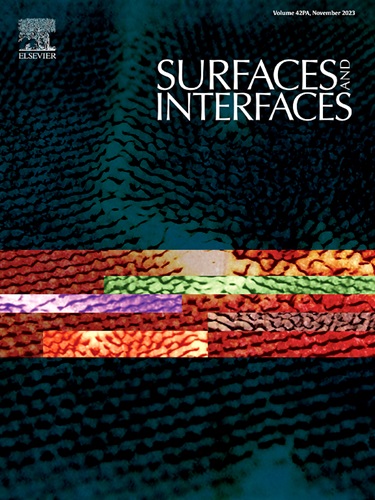Delafloxacin and Mercury adsorption via a triple-layered metallic hydroxide nanocomposite: Insights into the adsorption mechanism, sustainability, and eco-friendliness studies
IF 5.7
2区 材料科学
Q2 CHEMISTRY, PHYSICAL
引用次数: 0
Abstract
A triple-layered metallic hydroxide nano-sorbent was synthesized and employed as an eco-friendly and highly efficient adsorbent for the removal of Delafloxacin (DFX) antibiotic and Mercury (MC) from polluted aqueous solutions. The physicochemical characteristics of the synthesized adsorbent were thoroughly examined using various analytical techniques, including FTIR, XRD, FESEM/EDX, TGA/DTG, BET surface area analysis, zeta potential measurement, chemical stability, and particle size distribution analysis. The effects of various parameters, including pH, temperature, adsorbent dosage, and contact time, on the efficiency of MC and DFX removal were systematically investigated. The optimized parameters for MC adsorption were pH = 5, temperature = 25 °C, adsorbent dosage = 0.07 mg, and contact time = 30 min. For DFX uptake, the adjusted parameters were pH = 5, temperature = 25 °C, adsorbent dosage = 0.2 mg, and contact time = 60 min. Both the pseudo-first-order (PFO, R² = 0.99) and pseudo-second-order (PSO, R² = 0.99) models, along with the Freundlich (R² = 0.99, χ² = 2.77) isotherm model, were identified as the most suitable kinetic and isotherm models for analyzing the adsorption process of MC. In contrast, the removal mechanism of DFX was best described by the PFO model (R² = 0.99) and the Langmuir model (R² = 1, χ² = 2.15). Furthermore, an advanced statistical monolayer model was performed to clarify the removal mechanism of these pollutants, focusing on the orientation of the adsorbed molecules and the microscopic interactions occurring on the adsorbent surface. The extent of MC cations and DFX drug molecules adsorbed per functional group (n) in this nanocomposite was found to be 0.724 and 0.445, respectively. This indicates that the adsorption orientations are both parallel and non-parallel, resulting in multi-docking and multi-molecular interactions with MC cations, as well as horizontal alignment and multi-docking interactions with DFX molecules. The maximum removal capacities (Qsat) for MC and DFX were determined to be 35.79 mg/g and 429.11 mg/g, respectively. Thermodynamic studies were conducted at temperatures ranging from 25 to 55 °C for both pollutants, revealing that the interactions in both adsorption systems are endothermic. This nano-sorbent was effectively regenerated using various solvents, allowing for its reuse. The preparation process achieved an impressive BAGI ranking of 90.6, highlighting its exceptional practical applicability, strong production capabilities, potential for automation, and low operating costs. In summary, the findings of this study indicate that the triple -layered metallic hydroxide exhibits promising performance as a highly efficient, safe, low-cost, and eco-friendly adsorbent for the removal of pharmaceuticals and heavy metals from contaminated water.

求助全文
约1分钟内获得全文
求助全文
来源期刊

Surfaces and Interfaces
Chemistry-General Chemistry
CiteScore
8.50
自引率
6.50%
发文量
753
审稿时长
35 days
期刊介绍:
The aim of the journal is to provide a respectful outlet for ''sound science'' papers in all research areas on surfaces and interfaces. We define sound science papers as papers that describe new and well-executed research, but that do not necessarily provide brand new insights or are merely a description of research results.
Surfaces and Interfaces publishes research papers in all fields of surface science which may not always find the right home on first submission to our Elsevier sister journals (Applied Surface, Surface and Coatings Technology, Thin Solid Films)
 求助内容:
求助内容: 应助结果提醒方式:
应助结果提醒方式:


